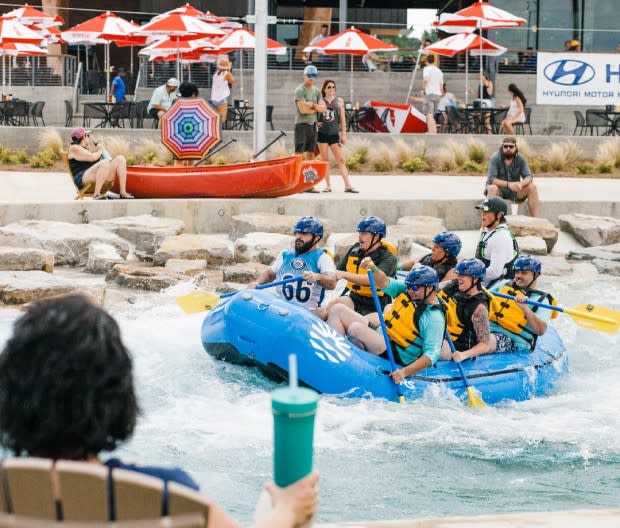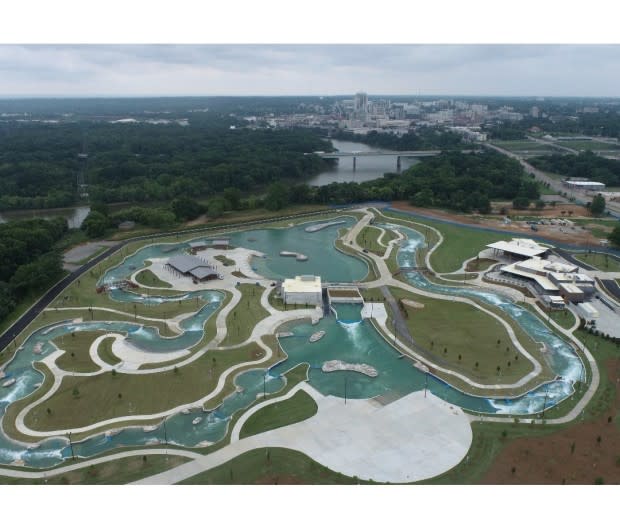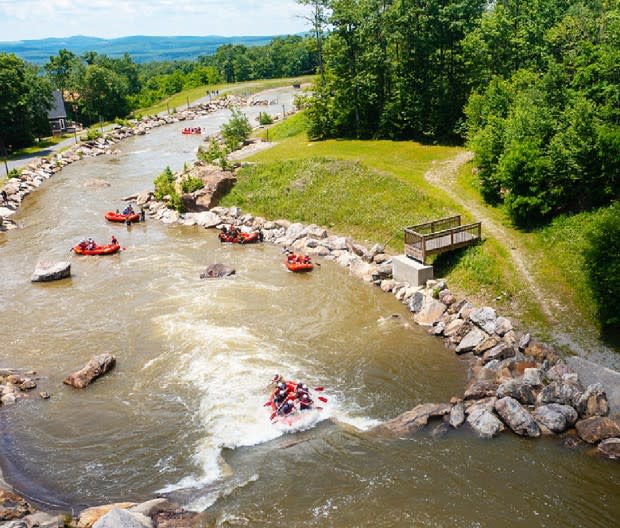The Latest Wave of Urban Whitewater Parks Are Making a Big Splash With City Paddlers
- Oops!Something went wrong.Please try again later.
Kelly Slater isn’t the only wavemaker bringing surf to the people. While his man-made Surf Ranch joins six other such wave pools in the U.S., wave tech has also come to the world of whitewater rafting and kayaking with a new breed of recirculating river parks making a huge splash around the country. The latest example of “urbanizing” recreation is pump-driven Montgomery Whitewater, a river park that opened July 2023 in Montgomery, AL. It's the nation’s fourth recirculating whitewater venue of, no doubt, more to come.
Revitalizing a formerly ailing stretch of the Alabama River coursing through downtown into a revenue-generating, recreational hotbed, Montgomery Whitewater joins Wisp Whitewater in McHenry, MD, Oklahoma City's Riversports Rapids, and the U.S. National Whitewater Center in Charlotte, NC, as well as a host of similar courses built worldwide for Olympic competitions from London and Sydney to China and Brazil.
“These parks are becoming event and activity hubs and the focal points of their communities,” says Scott Shipley, a three-time slalom kayak Olympian, whose firm, S2O Design and Engineering, has designed the majority of these recirculating rivers.
“They turn often under-utilized urban areas into true recreational amenities that are fun for the whole family,” adds Shipley. “Millennials want to have an adventure on their vacation, and parks like these make that possible.”
Related: A Kayaker's Guide to Channel Islands National Park
Like ocean waves, whitewater parks come in all shapes and sizes—from big-dollar recirculating parks to simple, one-wave structures revitalizing downtown riverbeds. No matter their scope, they’re re-energizing riverfronts while ushering in a new era of inland recreation. Golden, CO, developed one of the first such parks in 1996 on Clear Creek (of Coors beer fame). Today, an estimated 80 of them have cropped up on natural waterways throughout the country. Many of these repurposed venues have removed outdated and dangerous lowhead dams. The latest recirculating parks are more involved and expensive to make and maintain, relying on concrete channels and massive electric pumps to funnel water down the course.
As with ocean wave parks, modern engineering and modeling now create waves and rapids mimicking some of the country’s best whitewater rivers. Many parks even boast adjustable features (such as Shipley’s RapidBlocs) that can fine-tune waves for everything from slalom to surfing. Throw in other activities and amenities for guests—from restaurants, shops, and concert amphitheaters to cycling and hiking paths—and it’s no surprise these river parks are a huge hit.
“They bring rafting to the people and boost their local economies in the process,” adds Shipley, fresh from Montgomery’s grand opening, where he was the first to sample its watery wares. “Instead of spending serious money to travel to go rafting once a year, whitewater enthusiasts can now do it after work. They help create a great quality of life for their communities.”
Best Recirculating Whitewater Parks in America

Courtesy image
1. Best Overall: Montgomery Whitewater
Montgomery, AL
In the heart of downtown Montgomery, the nation’s newest recirculating whitewater park features a series of pool-drop rapids that have revitalized the city’s riverfront along the I-65 corridor. Montgomery Whitewater “is the world’s best whitewater park,” claims designer Shipley of S2O Designs, crediting this honorific to its massive campus along the Alabama River alongside an array of other outdoor activities, including climbing areas, ziplines, ropes courses, and trails for hiking and biking.

Courtesy image
The park’s recirculating whitewater course also flows among restaurants and shops, a hotel, beer garden, concert venue, and conference center. Anchoring the 120-acre park is its state-of-the-art, Olympic-rated whitewater course, offering everything from an easy, rec-friendly channel for unguided rafting and tubing to a freestyle, commercial rafting channel and higher-level competition venue.
“We took the best parts from all the other parks and put them into this one,” says Shipley. “It’s bringing a new vibrancy and economic development to Montgomery County and is truly changing the area’s quality of life—both for local residents, visitors, and even companies looking to move there.”

Courtesy image
2. Largest Whitewater Park: U.S. National Whitewater Center
Charlotte, NC
Billed as the world’s largest and most profitable whitewater park, with over a million visitors per year, the U.S. National Whitewater Center is a nonprofit committed to facilitating access to the outdoors. In addition to its world-class whitewater course, the facility is a full-fledged outdoor activity area and event center within its 1,300 acres of protected land—including 50 miles of trails and access to the Catawba River. The first such park in the country, its crown jewel is the whitewater park with its various channel systems totaling 4,570 feet in length. The water comes from a 12-million-gallon reservoir and seven massive pumps, each one capable of filling up an Olympic-sized swimming pool every 12 seconds.
The “river” serves up four distinct sections of whitewater, including channels for instruction, freestyle, wilderness, and competition—all comprising Class II-IV whitewater. Its “wilderness” section, featuring standing waves, holes, and eddy lines before splitting into instructional and freestyle channels, is by far its most popular, drawing more than 250,000 commercial rafters per year.

Courtesy image
“Rafting is definitely the facility’s number one activity as far as guest engagement,” says brand director Jesse Hyde, adding its annual Tuck Fest draws thousands of attendees and includes seven different paddling events.
The center’s 984-foot competition channel has hosted World Cup slalom races and is vying to host the Olympic Team Trials next year.
“Instead of making it an Olympic-level park that caters to rafters, it’s a rafting park that also caters to Olympic-level competition,” says course designer Shipley. “It’s a true outdoor adventure center right in the center of town.”

Courtesy image
3. Best Olympic-Standard Park: Riversports Rapids
Oklahoma City, OK
The $45 million Oklahoma Whitewater Center, known as Riversport Rapids, brings rollicking whitewater to downtown Oklahoma City. Located adjacent to the Oklahoma River, which offers competitive and recreational flatwater activities, the 11-acre course features the world’s highest-volume pumped channel, running at 1,200 to 1,400 cubic feet per second at full capacity.
“It builds off the lessons we learned from the earlier U.S. National Whitewater Center,” says park designer Shipley. “We tried to include something for everyone—with kids play areas, a concert stage, a paddle-in movie theater, an Olympic-standard course, a recreational course, and a game-changing freestyle feature.”

Courtesy image
Six giant pumps rapidly recirculate 8 million gallons of treated water through two channels to create Class II-IV rapids, with flows adjustable to a range of levels from beginner to Olympic-standard whitewater. Built in the city’s Boathouse District as part of a one-cent sales tax initiative to enhance the local quality of life, the park offers commercial and private rafting, tubing, and kayaking, as well as flatwater paddling and rowing on the adjacent Oklahoma River.
Other activities here include surfing, zip lining, climbing walls, sailing, a bike park and skills trail, and an indoor alpine skiing venue. Open daily throughout summer and on weekends in spring and fall, it hosts festivals, race events, and summer camps for kids.
The venue is also the official U.S. Olympic Committee Training Site for paddlesports, with a world championship-caliber sprint kayak and rowing course, Olympic-level whitewater slalom course, and high-performance elite athlete training center.

Courtesy image
4. Best for Families: Wisp Resort Whitewater Course
McHenry, MD
Launched in 2007, the Wisp Resort Whitewater Course is an Olympic-standard whitewater center located on a mountain above the Wisp Ski Resort at Deep Creek Lake. Since the ski operation already had a mountaintop reservoir for its snowmaking machines, it sited the course next to it to make use of its water in the summer. Four electric pumps can blast 650 cubic feet per second down a 1,900-foot-long, wave-filled gauntlet of whitewater serving everything from Class II-III to surging Class IV.
While the first 100 yards are the steepest and narrowest, the last 300 yards follow more of a pool-drop format, complete with a practice area with an easy put-in and take-out on either shore. Inflatable bladders called “wave shapers” can also reconfigure certain waves, so they’re better for kayak slalom training and events or rafting operations. It’s the latter that’s most popular, drawing splashhounds region-wide throughout the summer.

Courtesy image
“Our rafting operations are extremely popular with beginner rafters and families,” says Wisp’s Lori Zaloga, noting that the facility’s guided raft trips let paddlers stuff in as many laps in a self-bailing, six-person raft as you can in 90 minutes. “The course is also ideal for spectating—so mom, dad and the grandparents can watch from the riverside.” Since the water comes from Deep Creek Lake (the same source feeding the nearby Upper Youghiogheny River), it can be refreshingly cold. Wear appropriate attire for those inevitable splashes.
What Is a Recirculating Whitewater Park?
A recirculating whitewater park is a manmade channel with features built into the sides and bottom, many of them adjustable, that create waves like you’d find on a river. A series of large, industrial-sized pumps siphon water from a nearby source and pump it to a pool at the top, where gravity causes it to flow down the course. A conveyor belt carries boats and paddlers back to the start pool, allowing multiple laps on the course.
What Activities Do Whitewater Parks Offer?
Whitewater parks host commercial rafting experiences as well as kayaking, canoeing, tubing, and stand-up paddle board options. Most of them also offer an array of other activities, from climbing walls and ziplines to ropes courses, biking and hiking, and more. Many also offer gear rentals as well as restaurants, beer gardens, shops, concert venues, hotels, and even conference centers.
When Is the Best Time to Visit a Whitewater Park?
Due to air temperatures, recirculating whitewater parks are most often visited from spring to fall, with the most popular time to visit occurring during the heat of summer.
How Is the Water Recirculated?
Recirculating whitewater parks rely on a series of massive electric pumps to bring water from a nearby source—a river, lake, or pond—up to a pool at the top of the course. When full, the course flows downward through a manmade channel. The water is then pumped back up to the top of the course where it refills the upper pool, continuing the cycle.
How Much Do Whitewater Parks Cost?
Prices vary depending on the park, the duration, the type of trip (e.g. guided or not), and other factors. For guided rafting, rates range from $55 for a two-hour session up to $109 for a half-day pass. If you have the appropriate skills, you can also paddle the parks by yourself for less.
